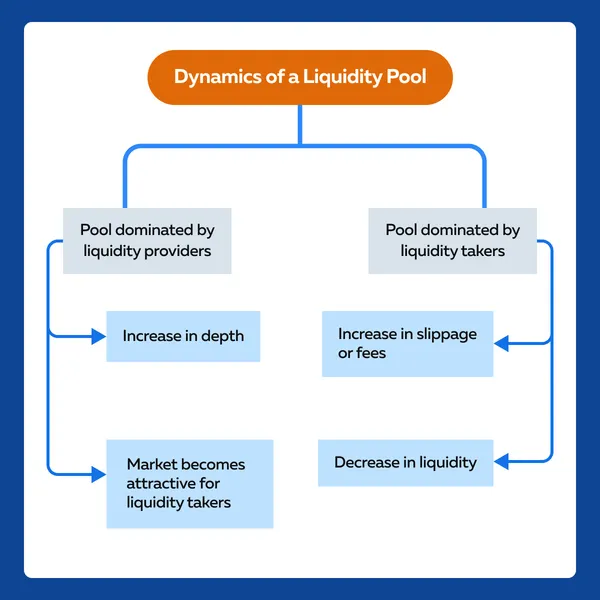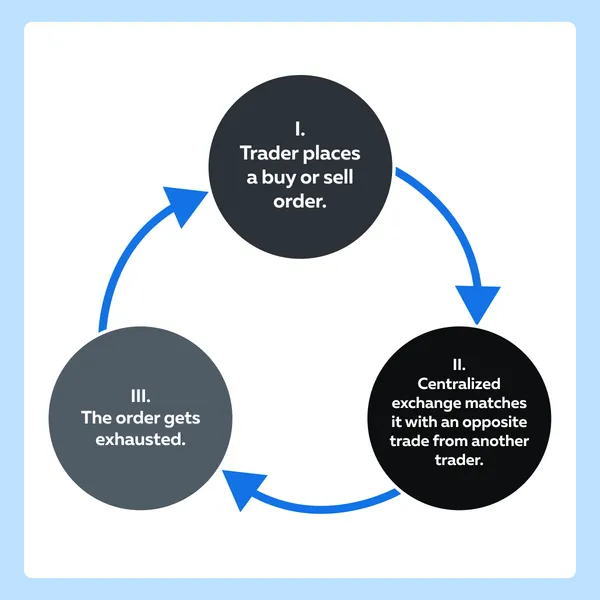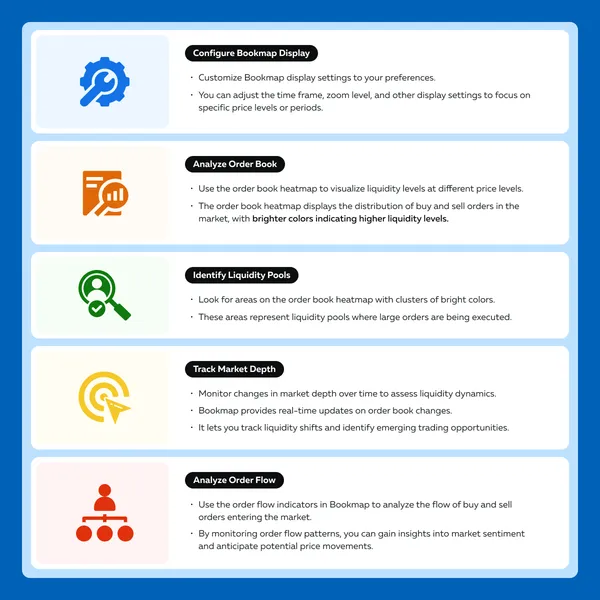Ready to see the market clearly?
Sign up now and make smarter trades today
Education
April 1, 2024
SHARE
Liquidity Pools and Trading: How to Identify and Trade Them

Liquidity pools play a vital role in shaping market dynamics. They enhance trading efficiency and provide opportunities for traders to execute trades with minimal market impact.
Through this article, we’ll understand liquidity pools and explore their functions in various financial markets, including centralized exchanges, decentralized finance (DeFi) platforms, and dark pools.
Then, we’ll examine techniques for identifying liquidity pools, such as order flow analysis, volume profile tools, and liquidity heatmaps. Lastly, we will explore case studies and historical market events, where liquidity pool dynamics played a significant role. By learning from these examples, traders can enhance their decision-making processes, mitigate risks, and ultimately become more successful in their trading endeavors. Let’s get started.
What are Liquidity Pools?
Liquidity pools are pools of assets. These are typically held in a smart contract or a centralized exchange, where users can trade without needing a counterparty. These pools are a fundamental component of financial markets as they provide liquidity for various assets, including:
- Cryptocurrencies,
- Tokens, and
- Traditional financial instruments like stocks and bonds.
In the context of liquidity pools, there exist two types of market players – liquidity providers and liquidity takers. Let’s understand their roles below.
| Role of Liquidity Providers | Role of Liquidity Takers |
|
|
It is worth noting that the dynamics of a liquidity pool depend on the balance between liquidity providers and takers. As more liquidity providers join a pool, its depth increases, making it more attractive for liquidity takers. Conversely, if liquidity takers dominate the pool, it may experience slippage or higher fees due to decreased liquidity.

What are the different types of liquidity pools?
The liquidity pools can be divided into three major parts:
- Centralized Exchanges
-
-
- Platforms like Binance or Coinbase operate centralized liquidity pools, where users can trade cryptocurrencies and other assets.
- These exchanges match buy and sell orders from their users and provide liquidity for various trading pairs.
-
- Decentralized Finance (DeFi) Platforms
-
-
- DeFi platforms like Uniswap or SushiSwap utilize automated market makers (AMMs) to create decentralized liquidity pools.
- Users can swap tokens directly from these pools.
- Also, anyone can become a liquidity provider by depositing assets into the pool’s smart contract.
-
- Dark Pools
-
- Dark pools are private liquidity pools operated by financial institutions.
- In these pools, large trades can be executed anonymously without impacting the market price.
- These pools are typically used by institutional investors to execute block trades with minimal market impact.
How Important is Liquidity in Trading?
Liquidity plays a crucial role in ensuring market efficiency. It allows assets to be bought and sold quickly at stable prices. In liquid markets, the presence of numerous buyers and sellers ensures that transactions occur at fair market prices, facilitating accurate price discovery.
Liquidity pools play a crucial role in financial markets by:
- Providing liquidity,
- Facilitating efficient trading, and
- Contributing to price discovery.
Let’s understand how.
- Price Discovery
-
-
- Liquidity pools contribute to price discovery by allowing assets to be traded at prevailing market prices.
- As more traders interact with a pool, the price adjusts to reflect supply and demand dynamics.
-
- Market Depth
-
-
- Liquidity pools with high liquidity offer greater market depth, meaning there are more buy and sell orders available at various price levels.
- This reduces price volatility and improves trading efficiency.
-
- Transaction Execution Quality
-
- Traders benefit from liquidity pools due to lower slippage and faster order fulfillment.
- This enables them to buy or sell assets with minimal market impact, even for large orders.
What is Profile Trading?
Profile trading is also known as volume profiling or market profile analysis. It is a trading strategy that focuses on analyzing the distribution of trading volume at different price levels over time. Using it, traders study the market’s volume profile to identify:
- Areas of high liquidity and
- Potential price levels, where the market may exhibit significant buying or selling pressure.
Here’s how profile trading works:
- Profile traders analyze historical trading volume data to identify price levels where significant volumes have been traded in the past.
- High liquidity areas are identified where a large volume of trades has occurred. These areas represent significant support or resistance levels, where a concentration of buy or sell orders exists.
- In high liquidity areas, the concentration of buy and sell orders tends to keep prices relatively stable.
- Profile traders look for trading opportunities within high liquidity areas such as entering trades near support or resistance levels based on the volume profile analysis.
Types of Liquidity Pools
There are different types of liquidity pools, such as:
- Centralized exchanges,
- DeFi platforms, and
- Dark pools.
Each type of pool offers unique liquidity solutions with its own set of advantages and challenges. Let’s understand these three liquidity pools in depth:
Centralized Exchanges:
Centralized exchanges operate liquidity pools through order books. These pools ensure continuous market liquidity by allowing traders to buy or sell assets at any time. When a trader places an order on a centralized exchange, the exchange finds a matching order from another trader and executes the trade, thus facilitating the trade.

Liquidity on centralized exchanges is provided by:
- Market makers,
- High-frequency traders, and
- Retail traders who place orders on the order book.
| Advantages | Disadvantages |
|
|
Decentralized Finance (DeFi) Platforms:
In DeFi platforms, liquidity pools are often implemented through automated market makers (AMMs). Liquidity providers deposit pairs of tokens into smart contracts, which are then used to facilitate trades. AMMs like Uniswap and SushiSwap use algorithms to:
- Automatically adjust token prices based on supply and demand and
- Provide continuous liquidity to traders.
Liquidity providers play a crucial role in maintaining liquidity in DeFi platforms by supplying assets to the liquidity pools. In return, LPs earn trading fees and additional rewards through staking and liquidity mining incentives.
Dark Pools:
Dark pools are off-exchange trading venues that offer increased privacy and reduced market impact for institutional investors. Trades executed in dark pools are not visible to the public until after they are completed. This anonymity allows institutional traders to execute large orders without affecting market prices.
| Benefits | Challenges |
|
|
Identifying and Trading Liquidity Pools
Identifying and trading liquidity pools require a combination of:
- Technical analysis,
- Order flow analysis, and
- Risk management techniques.
For identification, traders can use tools like order flow analysis, volume profile tools, and liquidity heatmaps. Let’s understand the identification process in depth:
- Order Flow Analysis
-
-
- Most traders analyze order flow data to identify liquidity clusters where large orders are being executed. Traders can identify areas of significant buying or selling pressure by monitoring the flow of orders entering the market.
- These areas indicate the presence of liquidity pools.
-
- Volume Profile Tools
-
-
- Volume profile tools display the distribution of trading volume at different price levels over a specified period.
- Traders can use volume profiles to identify areas of high liquidity where significant trading activity has occurred.
- These areas often serve as support or resistance levels, providing trading opportunities.
-
- Liquidity Heatmaps
-
- Liquidity heatmaps visualize liquidity levels across different price levels.
- These heatmaps also highlight areas with the highest concentration of buy and sell orders.
- Traders can use liquidity heatmaps to:
- Identify liquidity pools and
- Anticipate potential price movements based on order book dynamics.
How Does Bookmap Help in Identifying Liquidity Pools?
Bookmap is an advanced market analysis tool that provides visual representations of order book dynamics. It allows traders to identify liquidity pools and track market depth in real-time. Traders can use Bookmap to:
- Analyze order flow,
- Visualize liquidity clusters, and
- Identify trading opportunities
Let’s understand the identification process through a simple step-by-step guide.

Practical Trading Strategies
Most traders follow these two trading strategies:
| Market Making | Arbitrage |
|
|
How to Manage Risk?
Risk management is essential for:
- Mitigating trading risks and
- Preserving capital, when trading around liquidity pools.
By implementing effective risk management strategies, traders can navigate market volatility and uncertainty with confidence. Let’s study some effective risk management strategies.
- Slippage Management
-
-
- Traders can mitigate slippage risk by placing limit orders at specific price levels.
- By avoiding market orders, traders can control the impact of slippage on trade execution.
-
- Spread Widening
-
-
- During periods of high volatility or low liquidity, spreads usually widen and lead to increased trading costs.
- Traders can monitor spread dynamics and adjust their trading strategies accordingly to minimize the impact of spread widening on trade profitability.
-
- Order Book Depth Fluctuations
-
-
- Traders should monitor order book depth to:
- Assess liquidity conditions and
- Adjust their trading strategies accordingly.
- By staying vigilant, traders can ensure optimal trade execution.
- Traders should monitor order book depth to:
-
- Stop-loss Orders and Position Sizing
-
-
- Traders should use stop-loss orders to limit potential losses and manage risk exposure.
- Additionally, proper position sizing helps traders control risk and avoid overexposure to volatile market conditions.
-
- Market Surveillance Tools
-
- Traders can use market surveillance tools to:
- Monitor market activity,
- Detect unusual trading patterns, and
- Identify potential risks.
- By staying informed and vigilant, traders can proactively manage risks and protect their trading capital.
- Traders can use market surveillance tools to:
Case Studies and Examples
Liquidity pool dynamics can have a significant impact on trading outcomes during periods of market stress and volatility. Thus, traders must remain vigilant in monitoring liquidity conditions and be aware of historical market events to be better prepared for similar situations in the future.
Read the table below to explore some case studies and historical market events, where liquidity pool dynamics played a significant role in trading outcomes:
| Case Study | Event | Impact of Liquidity Pools | Lessons Learned |
| Flash Crash of May 6, 2010 | On May 6, 2010, the U.S. stock market experienced a sudden and severe decline, with the Dow Jones Industrial Average plunging nearly 1,000 points within minutes, only to recover most of the losses shortly afterward. |
|
|
| Ethereum Flash Crash of June 21, 2017 | On June 21, 2017, the price of Ethereum (ETH) plummeted from over $300 to as low as $0.10 on the GDAX exchange within a matter of seconds, triggering a flash crash. |
|
|
| COVID-19 Market Crash of March 2020 | In March 2020, global financial markets experienced a sharp and rapid decline in response to the COVID-19 pandemic, with major stock indices plunging into bear market territory. |
|
|
Conclusion
Understanding liquidity pools is crucial for successful trading. Liquidity pools affect how prices move and how trades are executed. By recognizing where liquidity is high, traders can make better decisions and reduce risks.
Precise identification of liquidity pools is the key. This can be done using advanced market analysis tools like Bookmap and its features like order flow analysis and heatmaps. Once identified, traders must manage risks carefully by using stop-loss orders and adjusting position sizes. Traders can also learn valuable lessons from past market events, flash crashes, and liquidity crises provide valuable lessons for traders.
Explore advanced order flow trading techniques and learn how to spot hidden liquidity with iceberg orders in our comprehensive guide: Advanced Order Flow Trading: Spotting Hidden Liquidity with Iceberg Orders. Gain valuable insights and level up your trading skills today!